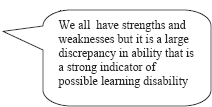The impact of the different barriers to learning will vary from one learner to the next.

The screening process helps to identify potential barriers to learning. As further information is gained through informal discussion, work samples and observation, a clearer understanding of barriers can be achieved. Together, the practitioner and learner can identify clues to investigate the legitimacy of barriers and how these barriers may impact the learning process. Identifying and investigating clues is an ongoing process. As the practitioner and learner relationship develops and the opportunities to observe the learning process become more frequent, the investigation becomes more intense. Together, the practitioner and learner can solve the mystery of learning.
Skill and Knowledge: you need to determine if the learner has the requisite knowledge and skills to perform a task. Be careful not to assume that a person has the required knowledge and skills.
Example: A learner's reading is slow which interferes with comprehension. He appears to read each word as a separate unit. The practitioner suggests that he look at a group of words instead of each one. This is a real eye opener for the learner since he always thought that he was to read each word as a separate unit. As he begins to use the reading strategy, his comprehension improves immensely. His barrier was due to a lack of knowledge, not a potential learning disability. This lack of knowledge can result if a learner has a history of frequently changing schools, has experienced long absences from school, or for many other reasons. Often, blocks to learning can result from a lack of knowledge of basic spelling rules or the steps required to organize and write a paragraph, to name just a few examples. If these gaps in skills and knowledge are addressed and there is no evidence of a learning disability, then progress should occur.
Areas to observe:

- General knowledge (gained from everyday interactions in the community)
- Social knowledge (customs, personal interactions)
- Information knowledge (concepts, vocabulary, skills and strategies)
- Metacognition (how one learns)